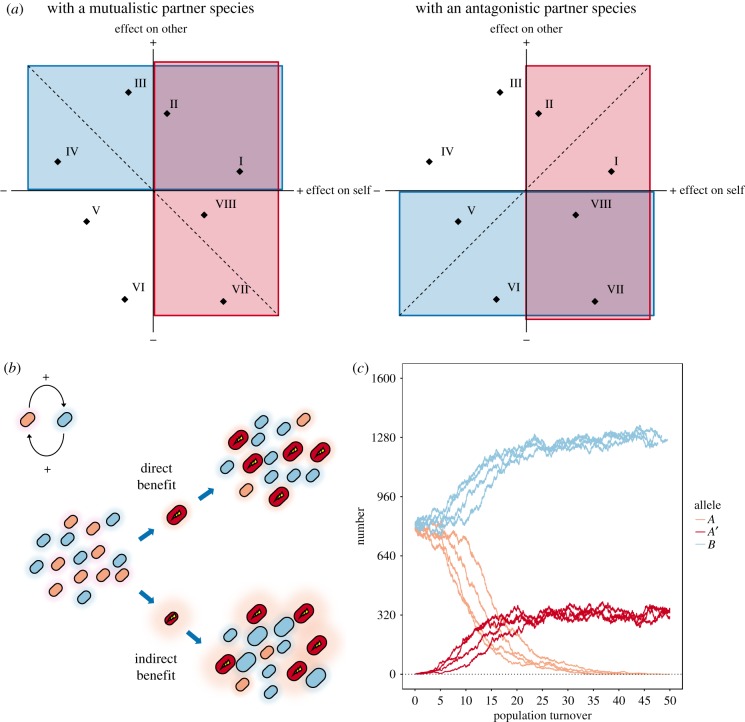Figure 3.
A conceptual and computational model for the evolution of microbial communities. (a) Schematic depicting the hypothesis put forward in this paper. Mutations may be selected because they have a positive effect on the individual itself (red boxes), and/or because they have a positive effect on a mutualistic species or a negative effect on an antagonistic species (blue boxes). When selection acts only on mutations with direct effects (in well-mixed environments), mutations that have a positive effect on the individual itself can increase in frequency (left and right panels: mutations I, II, VII and VIII). When selection acts on mutations with both direct and indirect effects (in spatially structured environments), mutations that have a net positive effect can increase in frequency. For example, in the left panel mutations to the top and right of the dashed—hypothetical trade-off—line (I, II, III and VIII) are associated with larger benefits than costs and may thus be positively selected. Conversely, mutations to the bottom and left of the dotted line (IV, V, VI and VII) are associated with larger costs than benefits and will thus be negatively selected. In the right panel, mutations to the bottom and right of the dotted line (I, VI, VII and VIII) may be positively selected, and mutations to the top and left of the dotted line (II, III, IV and V) will be negatively selected. This implies that in some cases mutations with direct fitness costs may be selected for, and mutations with direct fitness benefits selected against. (b) We modelled the case where two species (red and blue) have a positive initial effect on each other. Red individuals can evolve by the acquisition of two types of mutations. First, they may acquire mutations that provide a direct fitness benefit, such as becoming better at using a certain resource, or becoming more tolerant to a toxic compound. Individuals carrying such mutations should be able to increase in frequency in both spatially structured and well-mixed environments. Second, they may acquire mutations that provide an indirect fitness benefit, such as producing a costly compound that increases the growth of the blue species. Because the blue species has a positive effect on the red species, having more blue cells around, as well as each of these cells having a higher growth rate, also provides a fitness benefit to the red species (e.g. because the blue cells excrete a metabolic by-product that the red species can use, at a rate proportional to their growth rate). Individuals carrying such mutations should only be able to increase in frequency in spatially structured environments. Cell size reflects growth rate. (c) Population dynamics in 10 replicate runs of a simple cellular automaton model, simulating a spatially structured environment. Alleles A and B grow better when there are more cells of the other type in their immediate neighbourhood. A costly, more cooperative A′ mutant (conceptually equivalent to mutation III in the left panel of a) invaded in 4/10 simulations and reached an intermediate equilibrium frequency. By contrast, this mutant invaded in 0/10 replicates of a model simulating a well-mixed environment.

